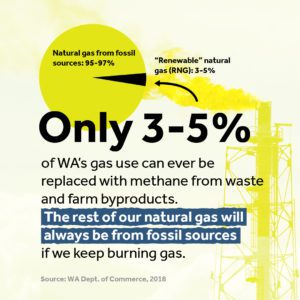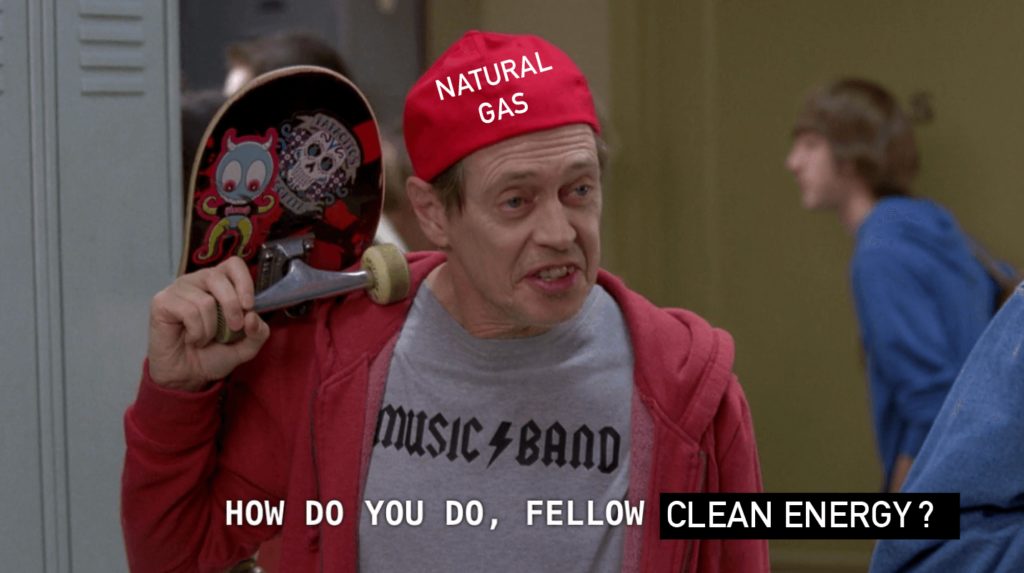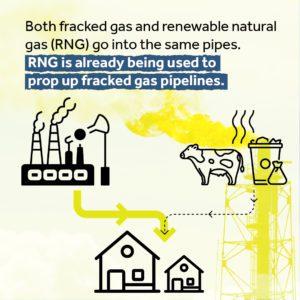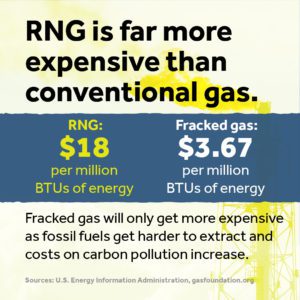Most fossil fuels get a cosmetic makeover from time to time. Coal became “clean coal,” oil became “ethical oil,” and the last administration even attempted — and ultimately failed — to brand natural gas from fracked oil wells as “freedom gas.”
But now, the oil and gas industry can no longer deny that climate change isn’t just knocking at the door, it’s walked right in and put its feet up on the sofa. So they’ve rolled out another trick: selling gas ratepayers the fantasy that their gas-burning furnaces and water heaters can be considered “renewable” by burning something the gas industry calls renewable natural gas, or RNG.
Only have a minute? Here’s the TL;DR.
Renewable natural gas (RNG) is methane captured from decaying plant and animal byproducts at farms and waste facilities. There could be a time and a place to use this methane — like generating on-site electricity at the source or for heavier industries that will have a difficult time going fossil-fuel-free. Beyond that, though, RNG props up an aging, leaky natural gas pipeline system that puts families’ health at risk and keeps our buildings hooked (literally) on fossil fuels. A report by the Washington State Department of Commerce found that, under a best-case scenario, “renewable gas” could only replace 3 to 5 percent of the state’s existing gas use. The rest of it? Almost entirely from fossil fuels. Renewable natural gas is a pipe dream.

Not sure why the need to limit methane (i.e., natural gas) is such a big deal? In a word, it accounts for about a quarter of the country’s climate-heating emissions, impacts respiratory health, and poses safety hazards from possible leaks and explosions. If that’s news to you, take a minute to look at our previous posts in this series about 1) why cutting methane is key to curbing climate change, and 2) how the gas industry has sold Americans the myth that natural gas is not like the other fossil fuels.
What is Renewable natural gas (RNG), and how is it different from conventional fossil gas?
Renewable natural gas (RNG) is methane captured from decaying plant and animal matter, while traditional gas piped into buildings is from large fossil fuel deposits — the same places we get oil and gasoline. At face value, capturing methane from sewage treatment plants, large farms and landfills sounds like a win-win. You can use the methane that would otherwise escape (and heat the planet at a rate of 20-84 times that of carbon dioxide), while getting energy out of the deal. Ah, if only energy were ever that simple.
Fossil fuel companies have funded multiple million-dollar campaigns to try and lump gas in with truly renewable sources of energy like wind and solar. Part of the strategy is to promote so-called renewable natural gas. One industry-funded group called Partnership for Energy Progress is doing just that in Washington and Oregon, with the help of Whatcom County’s gas provider Cascade Natural Gas.
Let’s dig into why RNG just won’t work in a clean energy future.

Issue 1: RNG doesn’t solve the health and safety problems that come with burning gas
This is a crucial point, so we’ll make it succinctly. Because what little RNG that’s produced will always be mixed in pipelines with fossil gas, it comes with all the same problems. What the gas industry is doing is like pouring a splash of diet soda into a full bottle and saying it’s sugar-free.
Gas stoves make indoor air quality have contaminant levels above what the EPA considers safe for breathing outdoors. Pipeline explosions, like the 2019 one in Seattle that injured three people, are still an issue. We won’t rehash all that here — see our post digging into common misconceptions about gas.
Gas pipelines still leak methane, a super-potent greenhouse gas no matter what the source of the methane is. Our climate can’t tell the difference between cow manure and gas unleashed from 200 million-year-old fossil deposits.
We’re saddled with the impacts for as long as we use gas at all, since RNG will never be able to sate the current hunger for gas. Which brings us to…
Issue 2: RNG can’t even replace enough gas to fuel stoves, let alone heat and hot water in homes
A report by the Washington State Department of Commerce found that, under a best-case scenario, “renewable gas” could only replace 3 to 5% of the state’s existing gas use — and it will cost consumers more than simply using renewable electricity. Residences with gas hookups, for example, account for about 26% of Washington’s gas use (more if you count leaks in pipelines along the way). RNG would only make a small dent in household gas usage, let alone reduce the massive amounts of gas used for industry, commercial buildings or for power generation. That’s less than what gas stoves use (about 8% of gas burned in homes), let alone being able to replace the other 92% of gas used for heat and hot water.
Even studies influenced by the gas industry itself think RNG could only ever replace 16% of the nation’s gas usage. When even wishful thinking doesn’t jibe with reality, you’ve got a problem.
Issue 3: RNG production relies on unsustainable industrial-scale agriculture—which is an equity and environmental justice problem.
Energy policy expert David Roberts sums it up nicely: “[RNG] is reliant on a steady supply of landfills and factory farms, which produce the very sort of pollution that electrification eliminates.”

The most likely sources of RNG are landfills and industrial dairy farms that happen to be significant sources of air and water pollution. Propping these industries up only further worsens pollution for communities living nearby.
Black, Indigenous, people of color and low-income Washingtonians are more likely to live in areas with worse indoor AND outdoor air pollution. Since natural gas pipelines will always be primarily methane gas from fossil fuel sources, supporting RNG keeps cycles of inequity right where they’ve always been.
Replacing gas-powered appliances at end-of-life with electric appliances (powered with clean energy) in existing buildings and electrifying all new buildings is the best way to limit air pollution both inside homes and outdoors near big RNG sources.
Issue 4: RNG is much more expensive than fossil fuel-derived gas, which is rapidly becoming more expensive than just going 100% electric
In general, gas prices have nowhere to go but up. Current artificially low prices are the product of the last decade’s increase in fracking technology, which is proving to be a consistent money loser for fossil fuel investors.

As you might guess, getting gas less conventionally from waste sources is even costlier. In March 2021, gas cost $3.67 per million BTUs of energy (EIA). When you use RNG, that jumps to $7–$20, with a median hovering around $18. That’s from a study prepared for the American Gas Foundation, an industry trade group. Again, the industry’s own numbers don’t make RNG pencil out unless it can continue to be subsidized by fossil gas.
Some gas utilities have even offered customers the option to pay extra for using RNG. But it ends up costing hundreds of extra dollars per year, which is money better spent to upgrade buildings to electric heating. Using efficient electric appliances instead of gas (“renewable” or fossil-based) allows families to save on utility bills and lower their home’s carbon emissions by 50%, as much as giving up your car entirely. That number is likely to get even better, especially in Washington, as our already quite renewable grid expands its solar and wind power generation. Additionally, Washington’s 2019 Clean Energy Transformation Act requires utilities to supply customers with 100% renewable or non-emitting electricity by 2045.
As gas gets harder to produce and as affordable, renewable electricity sources pick up more steam, putting our energy (pun intended) into developing more clean electricity makes more sense than siphoning gas from waste products at scale.
Issue 5: RNG should be reserved for specific, hard-to-electrify places — not piped into homes
There are some clear benefits to using methane from waste. The most apparent one is that capturing this methane prevents it from heating the climate, and methane is practically at an all-time high in our atmosphere. RNG can also be used to generate electricity on-site at farms and waste facilities.
For the next few decades at least, there will likely be some level of fossil fuel use. Let’s make sure that only happens in “hard-to-abate” sectors, such as heavy industry and aviation. If those needs switch from fracked gas to RNG, it’s certainly for the better. But for homes, buildings, transportation and our power grid? “Renewable” natural gas is just a crutch for a fossil fuel that’s going the way of coal.
Take action!
Here are two ways you can support a transition to clean electricity today.
— Ask your U.S. Representatives to support the federal Build Back Better reconciliation bill. It’s our best chance right now to fund meaningful climate action and infrastructure changes at the federal level:
— If you live in Bellingham, support the City Council in their efforts to reduce city-wide use of methane gas, which is about 40% of the city’s climate footprint:
